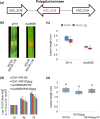OsPGIP1-Mediated Resistance to Bacterial Leaf Streak in Rice is Beyond Responsive to the Polygalacturonase of Xanthomonas oryzae pv. oryzicola
- PMID: 31832906
- PMCID: PMC6908543
- DOI: 10.1186/s12284-019-0352-4
OsPGIP1-Mediated Resistance to Bacterial Leaf Streak in Rice is Beyond Responsive to the Polygalacturonase of Xanthomonas oryzae pv. oryzicola
Abstract
Polygalacturonase-inhibiting proteins (PGIPs) have been shown to recognize fungal polygalacturonases (PGs), which initiate innate immunity in various plant species. Notably, the connection between rice OsPGIPs and PGs in Xanthomonas oryzae pv. oryzicola (Xoc), which causes bacterial leaf streak (BLS), remains unclear. Here, we show that OsPGIP1 was strongly induced after inoculating rice with the Xoc strain RS105. Furthermore, OsPGIP1-overexpressing (OV) and RNA interference (RNAi) rice lines increased and decreased, respectively, the resistance of rice to RS105, indicating that OsPGIP1 contributes to BLS resistance. Subsequently, we generated the unique PG mutant RS105Δpg, the virulence of which is attenuated compared to that of RS105. Surprisingly, the lesion lengths caused by RS105Δpg were similar to those caused by RS105 in the OV lines compared with wild-type ZH11 with reduced Xoc susceptibility. However, the lesion lengths caused by RS105Δpg were still significantly shorter in the OV lines than in ZH11, implying that OsPGIP1-mediated BLS resistance could respond to other virulence factors in addition to PGs. To explore the OsPGIP1-mediated resistance, RNA-seq analysis were performed and showed that many plant cell wall-associated genes and several MYB transcription factor genes were specifically expressed or more highly induced in the OV lines compared to ZH11 postinoculation with RS105. Consistent with the expression of the differentially expressed genes, the OV plants accumulated a higher content of jasmonic acid (JA) than ZH11 postinoculation with RS105, suggesting that the OsPGIP1-mediated resistance to BLS is mainly dependent on the plant cell wall-associated immunity and the JA signaling pathway.
Keywords: Bacterial leaf streak; Cell wall-associated genes; Defense; Jasmonic acid; Polygalacturonase-inhibiting proteins; Rice; Sheath blight.
Conflict of interest statement
The authors declare that they have no competing interests.
Figures






Similar articles
-
AvrXa7-Xa7 mediated defense in rice can be suppressed by transcriptional activator-like effectors TAL6 and TAL11a from Xanthomonas oryzae pv. oryzicola.Mol Plant Microbe Interact. 2014 Sep;27(9):983-95. doi: 10.1094/MPMI-09-13-0279-R. Mol Plant Microbe Interact. 2014. Retraction in: Mol Plant Microbe Interact. 2014 Dec;27(12):1413. PMID: 25105804 Retracted.
-
Comparative transcriptomic profiling of the two-stage response of rice to Xanthomonas oryzae pv. oryzicola interaction with two different pathogenic strains.BMC Plant Biol. 2024 Apr 29;24(1):347. doi: 10.1186/s12870-024-05060-1. BMC Plant Biol. 2024. PMID: 38684939 Free PMC article.
-
A Transcription Activator-Like Effector Tal7 of Xanthomonas oryzae pv. oryzicola Activates Rice Gene Os09g29100 to Suppress Rice Immunity.Sci Rep. 2017 Jul 11;7(1):5089. doi: 10.1038/s41598-017-04800-8. Sci Rep. 2017. PMID: 28698641 Free PMC article.
-
Resistance Genes and their Interactions with Bacterial Blight/Leaf Streak Pathogens (Xanthomonas oryzae) in Rice (Oryza sativa L.)-an Updated Review.Rice (N Y). 2020 Jan 8;13(1):3. doi: 10.1186/s12284-019-0358-y. Rice (N Y). 2020. PMID: 31915945 Free PMC article. Review.
-
Rice Routes of Countering Xanthomonas oryzae.Int J Mol Sci. 2018 Oct 2;19(10):3008. doi: 10.3390/ijms19103008. Int J Mol Sci. 2018. PMID: 30279356 Free PMC article. Review.
Cited by
-
Activated Expression of Rice DMR6-like Gene OsS3H Partially Explores the Susceptibility to Bacterial Leaf Streak Mediated by Knock-Out OsF3H04g.Int J Mol Sci. 2023 Aug 26;24(17):13263. doi: 10.3390/ijms241713263. Int J Mol Sci. 2023. PMID: 37686066 Free PMC article.
-
Interaction between Brassica napus polygalacturonase inhibition proteins and Sclerotinia sclerotiorum polygalacturonase: implications for rapeseed resistance to fungal infection.Planta. 2021 Jan 18;253(2):34. doi: 10.1007/s00425-020-03556-2. Planta. 2021. PMID: 33459878
-
A LBD transcription factor from moso bamboo, PheLBD12, regulates plant height in transgenic rice.Plant Mol Biol. 2024 Sep 3;114(5):95. doi: 10.1007/s11103-024-01487-0. Plant Mol Biol. 2024. PMID: 39223419
-
OsHsfB4d Binds the Promoter and Regulates the Expression of OsHsp18.0-CI to Resistant Against Xanthomonas Oryzae.Rice (N Y). 2020 May 27;13(1):28. doi: 10.1186/s12284-020-00388-2. Rice (N Y). 2020. PMID: 32462553 Free PMC article.
-
A Novel Guanine Elicitor Stimulates Immunity in Arabidopsis and Rice by Ethylene and Jasmonic Acid Signaling Pathways.Front Plant Sci. 2022 Feb 17;13:841228. doi: 10.3389/fpls.2022.841228. eCollection 2022. Front Plant Sci. 2022. PMID: 35251109 Free PMC article.
References
-
- Agüero CB, Uratsu SL, Greve C, Powell AT, Labavitch JM, Meredith CP, Dandekar AM. Evaluation of tolerance to Pierce’s disease and Botrytis in transgenic plants of Vitis vinifera L. expressing the pear PGIP gene. Mol Plant Pathol. 2005;6:43–51. - PubMed
-
- Bacete L, Mélida H, Miedes E, Molina A. Plant cell wall-mediated immunity: cell wall changes trigger disease resistance responses. Plant J. 2018;93:614–636. - PubMed
-
- Benedetti M, Andreani F, Leggio C, Galantini L, Di Matteo A, Pavel NV, De Lorenzo G, Cervone F, Federici L, Sicilia F. A single amino-acid substitution allows endo-polygalacturonase of Fusarium verticillioides to acquire recognition by PGIP2 from Phaseolus vulgaris. PLoS One. 2013;8:e80610. - PMC - PubMed
Grants and funding
- 2018ZX08010-05B/National Program of Transgenic Variety Development of China
- 2016ZX08001-002/National Program of Transgenic Variety Development of China
- JQ201807/Natural Science Fund for Outstanding Young Scholars of Shandong Province
- SDAIT-17-06/Shandong Modern Agricultural Technology & Industry system
LinkOut - more resources
Full Text Sources

